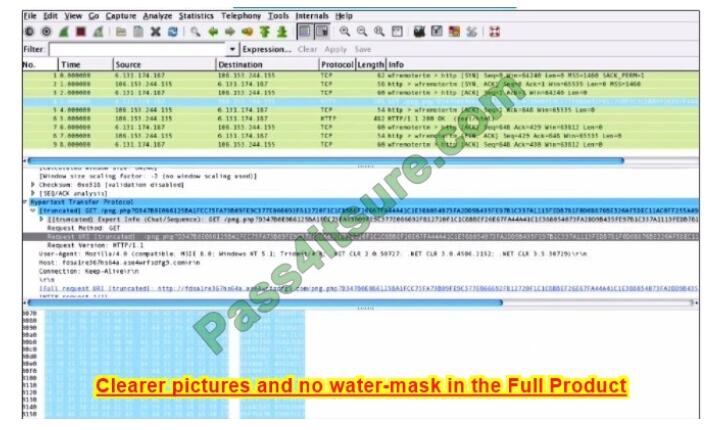Exam A
QUESTION 1
Refer to the exhibit. Assuming that the routing protocol for this network is EIGRP, if the link between R1 and R3 failed what would R4 receive from R3?
A. R4 would receive an update noting R3’s higher cost to reach 172.30.1.0/24.
B. R4 would not receive any updates or queries, since R3 would simply move to the path through R2.
C. R4 would receive a query, since R3 would mark 172.30.1.0/24 as active when the link between R1 and R4 failed.
D. R4 would not receive any packets, since R3 is not using the link to R1 to reach 172.30.1.0/24.
Correct Answer: A
QUESTION 2
Multicast addresses in which range are reserved by the IANA for administratively scoped multicast?
A. 239.0.0.0?39.255.255.255
B. 232.0.0.0?32.255.255.255
C. 224.0.0.0?24.0.0.255
D. 233.0.0.0?33.255.255.255
Correct Answer: A
QUESTION 3
Which two of these are reasons why some ports do not reply to RSTP proposals? (Choose two.)
A. the age time has expired
B. the remote bridge is in the discarding state
C. the remote bridge does not understand RSTP BPDU
D. the remote bridge is in the forwarding state
Correct Answer: BC
QUESTION 4
You are using IPv6, and would like to configure EIGRPv3. Which three of these correctly describe how you can perform this configuration? (Choose three.)
A. EIGRP for IPv6 is directly configured on the interfaces over which it runs.
B. EIGRP for IPv6 is not configured on the interfaces over which it runs, but if a user uses passive-interface configuration, EIGRP for IPv6 needs to be configured on the interface that is made passive.
C. There is a network statement configuration in EIGRP for IPv6, the same as for IPv4.
C. There is no network statement configuration in EIGRP for IPv6.
D. When a user uses a passive-interface configuration, EIGRP for IPv6 does not need to be configured on the interface that is made passive.
E. When a user uses a non-passive-interface configuration, EIGRP for IPv6 does not need to be configured on the interface that is made passive
Correct Answer: ADE
QUESTION 5
Which information is carried in an OSPFv3 intra-area-prefix LSA?
A. IPv6 prefixes
B. link-local addresses
C. solicited node multicast addresses
D. IPv6 prefixes and topology information
Correct Answer: A
QUESTION 6
Which three statements accurately describe a link-state routing protocol? (Choose three.)
A. Each router sends routing information to all nodes in the flooding domain.
B. Each router sends all or some portion of its routing table to neighboring routers.
C. Each router individually builds a picture of the entire flooding domain.
D. Each router has knowledge of all other routers in the flooding domain.
E. Each router is only aware of neighboring routers.
F. Each router installs routes directly from the routing updates into the routing table.
Correct Answer: ACD
QUESTION 7
Which three of these statements about penultimate hop popping are true? (Choose three.)
A. It is used only for directly connected subnets or aggregate routes.
B. It can only be used with LDP.
C. It is only used when two or more labels are stacked.
D. It enables the Edge LSR to request a label pop operation from its upstream neighbors.
E. It is requested through TDP using a special label value that is also called the implicit-null value.
F. It is requested through LDP using a special label value that is also called the implicit-null value.
Correct Answer: ADF
QUESTION 8
Refer to the exhibit. A network engineer has connected a packet-capturing device to the common broadcast segment in this network, on which all the routers are configured to run OSPF. By examining various show commands on the routers, the engineer discovers that the designated router is R1. By examining the captured packets, the engineer also discovers that every new LSA that R3 sends to the link, R1 resends to the link a few moments later.
Is this correct OSPF operation, and why or why not?
A. This is correct operation; flooding new LSA information to the other routers is a function of the designated router.
B. This is incorrect operation; each new LSA should only be flooded onto a given broadcast link once.
C. This is correct operation; OSPF uses a scheme whereby each LSA flooded onto a link is acknowledged by the receiving router through a reflood back onto the link of the same information.
D. This is incorrect operation; it indicates that while R3 can send packets to R1, R1 cannot send packets to R3.
Correct Answer: A
QUESTION 9
You are configuring the Cisco IOS DHCP Server to handle DHCP in a LAN. Which two of these configurations are required in order for DHCP to work? (Choose two.)
A. configure manual bindings
B. configure a DHCP address pool
C. configure a DHCP server boot file
D. exclude those IP addresses that will not be used in DHCP
E. configure the timeout value for ping packets
Correct Answer: BD
QUESTION 10
Refer to the exhibit. Which switching feature is being tested?
A. loop guard
B. PortFast
C. root guard
D. BDPU guard
Correct Answer: A

